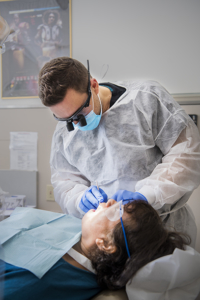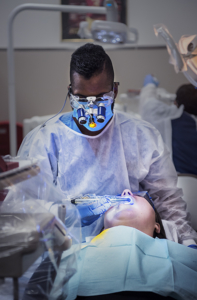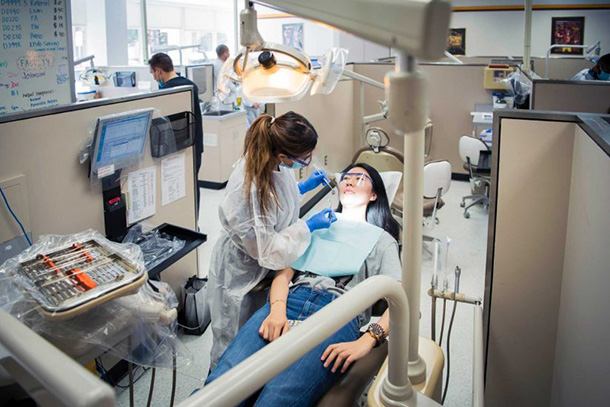For nearly a week, Julia Fregoso experienced tooth pain so severe that she was unable to sleep, let alone eat or drink.
The pain, resulting from a molar she broke last December, landed Fregoso in the Herman Ostrow School of Dentistry of USC Urgent Care and Dental Trauma Center at the recommendation of her mother.
“The night after my extraction was the first night in almost a week that I actually slept throughout the night,” Fregoso said. “Less than 24 hours later, I was able to eat and speak with no pain and little to no swelling. I’m feeling so much better!”

Dental student Eric Chiccone provides treatment to Analine Sanchez, 58, who visited the Urgent Care and Dental Trauma Center complaining of jaw pain. (Photo/Hannah Benet)
Fregoso is a textbook example of the kind of patients that walk into Ostrow’s urgent care clinic, which is dedicated to the prevention, diagnosis and treatment of dental emergencies.
Under the supervision of faculty dentists, Ostrow dental students provide treatment at the clinic during a required two-week rotation that is divided between their third and fourth year of dental school.
“We mostly get patients who have not had regular dental treatment, so the problem gets compounded over time, and the pain becomes unbearable,” said Elieka Salamipour, a third-year student who recently finished her first one-week rotation.
On any given day, students can treat anywhere from 20 to 45 patients with a wide range of dental needs, such as root canals, extractions, cavities and cracked teeth.
“It’s nonstop,” Salamipour said. “You don’t know who’s going to come through the door or what the patient is going to need. The rotation does so much for developing and refining a dental student’s approach to diagnosis and patient care.”
Every week, approximately 10 students rotate through the clinic, where they assess and diagnose patients on their own before presenting their approach to supervising faculty who are there to intervene or make recommendations, only if necessary.
“Basically, as soon as we meet the patient, we are on our own,” said Jimmy Huettner, a third-year student who also recently completed his first one-week rotation. “We diagnose and treat them exactly like we would be doing in the real world.”
Comprehensive rotation
The clinic’s unique rotation format can largely be credited to its director, Ramon Roges, DDS, who also is an associate professor of clinical dentistry at Ostrow.
“Dr. Roges has really set up a phenomenal rotation in that it creates a learning environment for us as students and a really efficient way to treat patients, helping as many as we can each day,” Huettner said.
Roges believes the rotation teaches students invaluable skills such as time management because they see multiple patients and treat multiple conditions.
“They also get emergency dental treatment experience, which sooner or later they are going to need in their private practice,” Roges said.
When students return to the clinic for their fourth-year rotation, Roges often sees a huge difference in their abilities.
“They have more self-confidence, they work faster and they know how to treat the patient,” Roges said. “They also know how to communicate better.”
Even though she recently finished her first rotation, Salamipour already feels more comfortable when seeing patients.
“I have become more confident in examinations and diagnosis,” said Salamipour, who now volunteers at the clinic in her free time. “The urgent care faculty is phenomenal. Having them there to bounce off ideas and questions is great. There is so much to learn from them and their different approaches help you refine your personal style as a dentist.”
Besides having to think quickly and work well under pressure in an emergency dental setting, students must also learn how to work with patients during what is arguably not their finest hour.
“Most of the patients you are going to see in emergency are in pain, so they are not happy campers,” Roges said. “So you are dealing with an individual that either has discomfort or is seeking some kind of relief, and sometimes it can be difficult to interact with them.”

Lana Kanen, 18, seen here with doctor of dentistry student Trey Coke, visited the Urgent Care and Dental Trauma Center after chipping her tooth. (Photo/Hannah Benet)
Compassionate caregivers
Working under these circumstances can be stressful for any dentist, but it is a challenge that Salamipour relishes.
“You need compassion to understand the pain of patients,” Salamipour said. “I get a sense of pride being able to work with people in compromising situations. I’ve learned to put people at ease, work with different personalities and de-escalate concerns and fears.”
Salamipour recently met with a patient who had a longstanding fear of the dentist.
“At the end of the session, she gave me a hug and said, ‘Keep doing what you are doing. I’m looking forward to my next appointment,’ ” Salamipour said.
Ryan Shapiro, MCM, has had his fair share of dental appointments at Ostrow — he’s been a patient since he was 12 years old.
“My dad brought me after I knocked out two of my teeth doing something stupid on my bike,” Shapiro said. “I was in pain and embarrassed about how I looked. The staff at USC was very kind and professional over several visits, making my teeth look even better than ever before.”
Shapiro went on to attend USC and played on the 2000 football team. Roges made the mouthguard he used on the Trojan football field.
Even though he graduated from USC in 2011 with a graduate degree in communication management, Shapiro continues to entrust his dental care to the Ostrow team.
Roges said it is rewarding when patients like Shapiro keep returning, but he especially enjoys being able to provide dental care to those who need it the most.
“We treat a lot of patients that come from the surrounding communities who cannot afford to go to a private dental office,” Roges said.
Once their urgent dental issues are treated, Roges urges them to become Ostrow patients for their regular dental care.
“You don’t want to keep waiting for another emergency to have to come back again,” Roges said. “You don’t want to have a domino effect, to go from one emergency to the other. We want our friends in the community to be healthy.”
— Stephanie Corral


